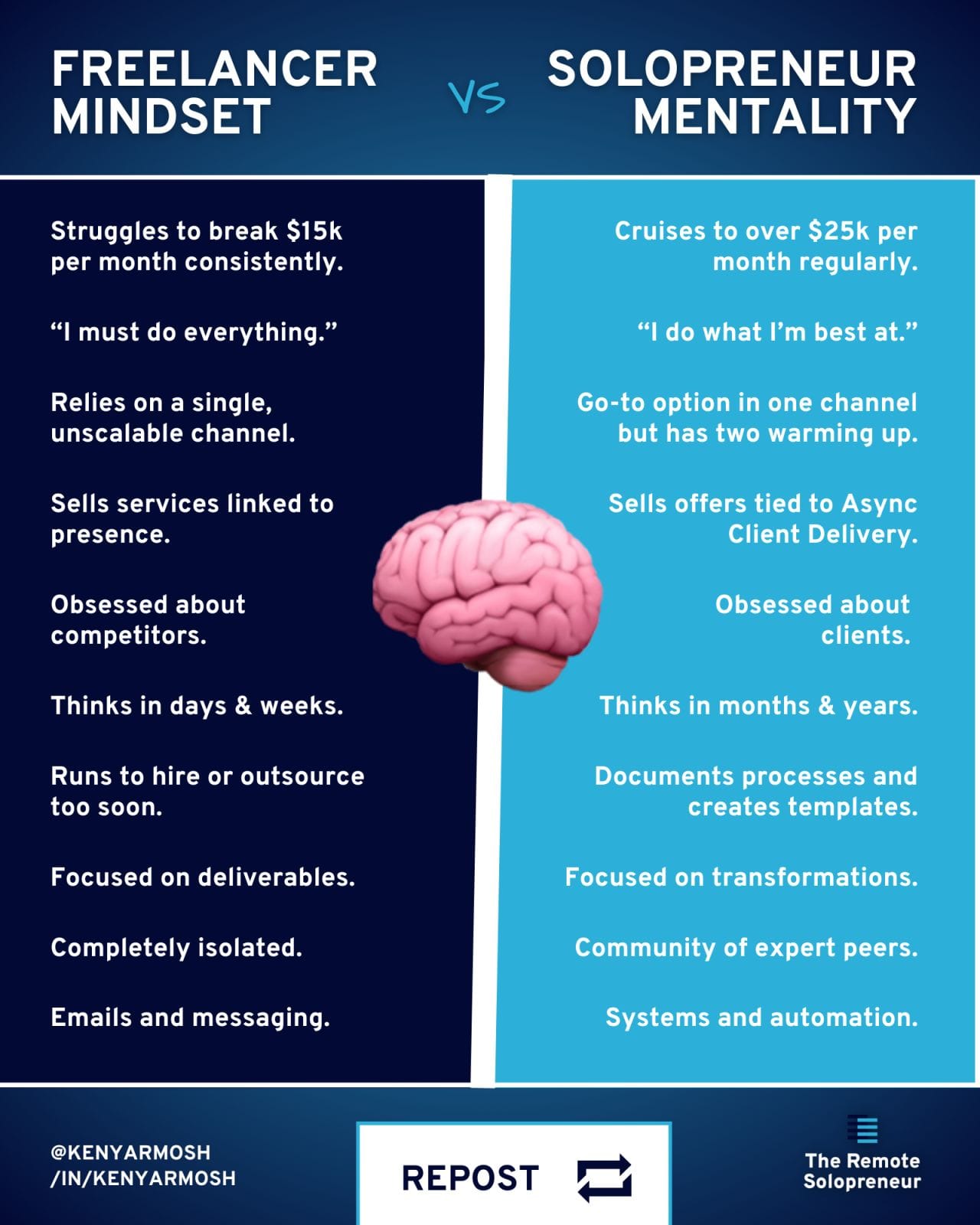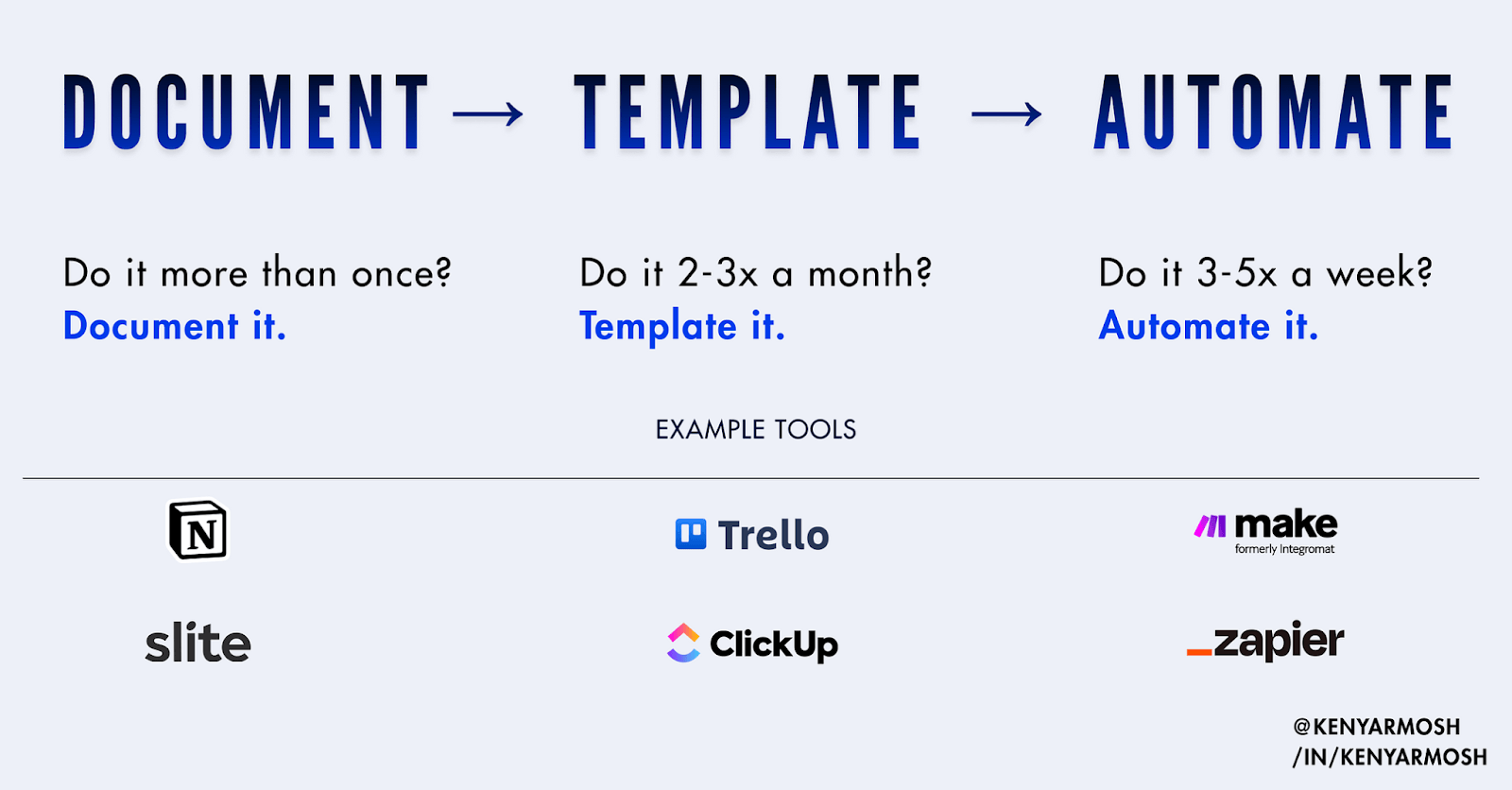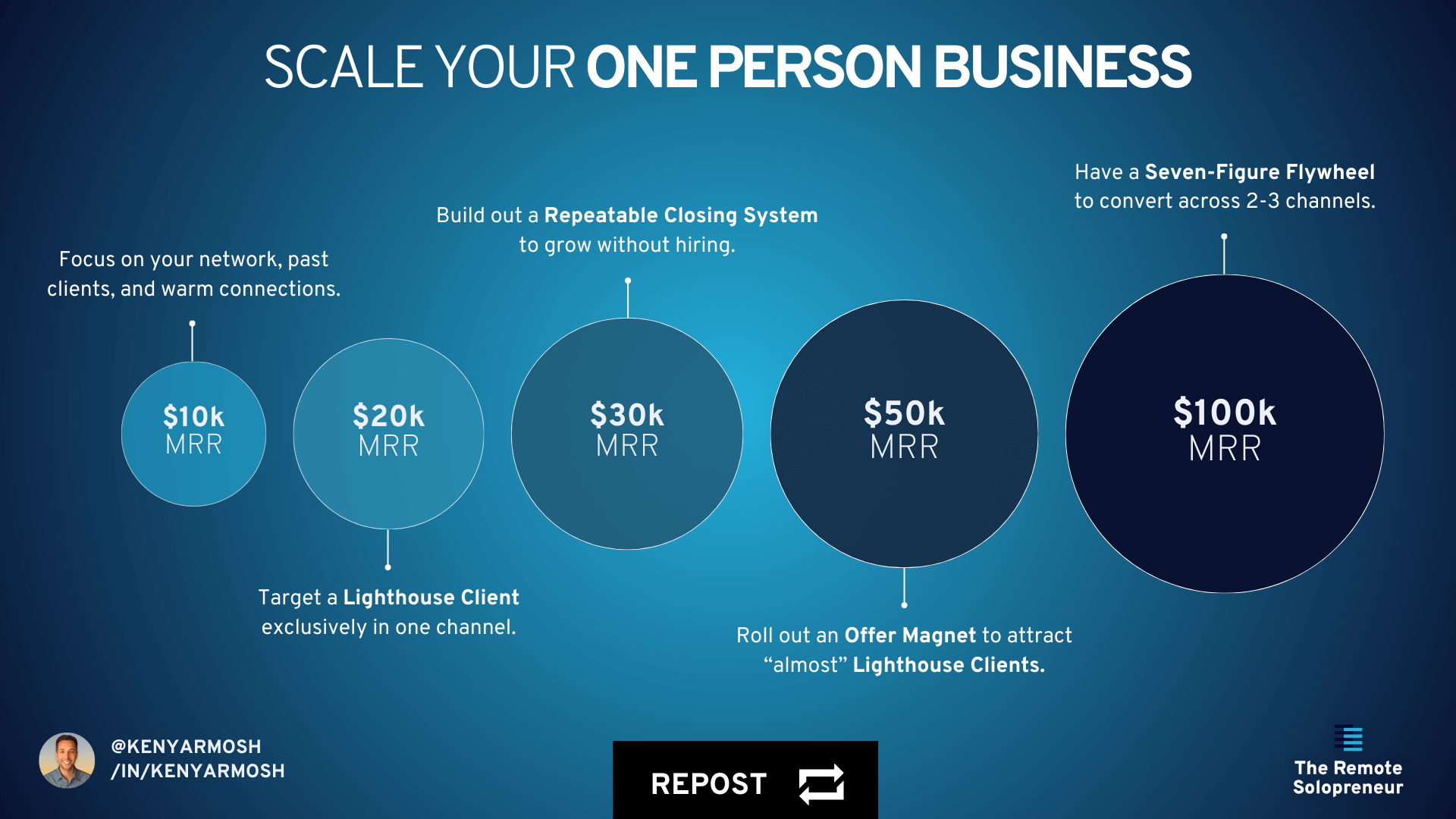🚀 TL;DR
- Starting a one-person business is about simplifying decisions, choosing a clear business model, and focusing on a narrow audience you can serve well.
- Launching quickly with a small, testable offer is better than overplanning, since real feedback is more valuable than assumptions.
- Services are the easiest starting point, but solo businesses can evolve into products, subscriptions, or digital assets for scalability.
- Automation, tools, and selective outsourcing help reduce busywork so you can spend time on high-impact activities.
- Staying connected through communities and treating your business as an ongoing experiment prevents isolation and keeps you adaptable.
You don’t need permission to start your own business.
I want that to sink in.
I didn’t have special connections when I launched my one-person business in 2022. No massive following. No startup capital. What I did have was the expertise people needed, a commitment to solving real problems, and a willingness to put my thinking out into the world.
Most people overcomplicate starting a business. They think they need perfect branding, complex systems, and a business plan the size of a novel.
The truth? A one-person business doesn’t need a comprehensive business plan. It needs action and quick feedback.
I’ve helped hundreds of solopreneurs launch by treating their businesses as experimental labs rather than rigid structures. When you’re flying solo, you can test ideas on Monday, pivot on Wednesday, and launch something new by Friday.
Throughout this guide, I’ll share my experiences scaling multiple seven-figure businesses as a solopreneur and the lessons I’ve learned helping others do the same.
What do you need to start a one-person business?
Most people think starting a business requires mountains of capital, years of planning, and complex infrastructure.
For traditional businesses, maybe.
For a one-person business? You need far less than you think.
I’ve built multiple seven-figure businesses as a solopreneur since 2005 and helped hundreds of others do the same. The formula is simpler than most gurus would have you believe.
Let’s break down what you actually need to get started:
High-value skill with expertise
A successful one-person business starts with what you already know how to do well. This doesn’t mean you need to be the world’s foremost expert. You need to be good enough to deliver real value to specific people with specific problems.
When I started my latest business, I didn’t try to compete with massive business consulting firms.
I focused on where my experience gave me a unique advantage: helping experienced professionals scale without hiring teams. Your expertise might come from your career, self-education, or a combination of experiences that give you a unique perspective.
A solo business works best when it reflects your obsessions. You’re not scaling a one-person company—you’re scaling your curiosity. Look at what people have already asked for your help with. Where do colleagues or friends regularly seek your advice? Those questions often point toward your most marketable skills.
Clarity on your offer
Vague offers create vague results. Your potential clients need to understand what you do and who you do it for.
The more precise your offer, the easier it is to find clients who need what you provide. Instead of “ecommerce business coaching,” consider “helping ecommerce business owners scale to $50K monthly revenue without paid advertising.”
When working with solopreneurs, I help them develop what I call “Lighthouse Client” targeting—identifying the specific type of client (and target audience) who will benefit most from their expertise and be willing to pay premium rates for it.
Your offer should clearly communicate who it’s for, what problem it solves, how it’s delivered, what results clients can expect, and why you’re uniquely qualified to provide it. Don’t worry about getting it perfect from day one. Your offer will evolve as you learn more about what your market wants.
Proof that the market wants it
You can have the best idea in the world, but if no one wants to pay for it, you don’t have a business. Before investing heavily in your one-person business, validate that there’s genuine demand.
This doesn’t require complex market research. I didn’t build an elaborate program when I launched my coaching service. I started with conversations with potential clients about their needs, then created a basic offer addressing their most pressing challenges.
Start small. Have conversations with potential clients, offer a scaled-down version of your service to a few people at a reduced rate, create high-quality content addressing the problem you solve and gauge interest, or look for others succeeding in similar spaces (competition is validation).
Too many potential solopreneurs get trapped in endless planning. They want everything to be perfect before launching. I’ve seen this paralyze talented people for months or even years.
You’ll learn more from two weeks of real client work than from two months of planning.
9 steps to start a one-person business
Now that you understand the fundamentals, let’s break down the practical steps to get your business off the ground:
Step 1: Craft a clear business idea
Your business idea doesn’t need to be revolutionary. It needs to be specific and valuable.
When I started helping solopreneurs scale efficiently, I didn’t invent a new category. I focused on solving a specific problem better than anyone else.
To craft your business idea, ask yourself:
- What skills do you have that others find valuable?
- What problems are you uniquely positioned to solve?
- Who has these problems and is willing to pay?
- How can you package your solution differently?
The best business ideas come from the intersection of what you’re good at, what you enjoy doing, and what people will pay for.
I’ve seen too many new solopreneurs focus exclusively on market gaps while ignoring their own strengths and interests. Building a business around skills you don’t enjoy or excel at is a recipe for burnout.
Start with your curiosities, not market gaps. Build from enthusiasm, and trust that consistency will lead to clarity and growth.
Step 2: Find your Unique Value Proposition (UVP)
In a crowded market, you need to clearly articulate why someone should work with you instead of all the other options. Your unique value proposition (UVP) is the specific promise of value you’ll deliver that sets you apart.
I spent weeks refining my UVP, which centers on helping solopreneurs build systems that scale their impact without traditional hiring. To date, I have looked at signals in the market and adjusted accordingly.
When developing your UVP, consider what aspect of your background gives you a unique perspective. This should reflect in how your approach differs from conventional methods and the results you can deliver that others can’t.

Your UVP should be specific enough to be memorable but broad enough to appeal to your target market. Focus on outcomes, not just services.
Step 3: Conduct market research (And validate demand)
Before investing significant time and resources, validate that there’s genuine demand for your offering. This doesn’t require expensive market research tools.
When I launched my solopreneur community, I didn’t spend months building an elaborate platform. I started with a small group of business peers, delivered exceptional value, and let word-of-mouth drive growth.
Start with direct conversations with potential clients about their challenges. Analyze online communities where your target clients gather. Review competitors to identify gaps in the market. Create small test offers to gauge interest.
Be particularly attentive to the language people use to describe their problems. Look at what solutions they’ve already tried, what outcomes they’re seeking, and how urgent their need is. This information will validate your idea and shape your messaging, pricing structure, and delivery.
Step 4: Select a business model
There are countless ways to structure a one-person business. The right model depends on your skills, goals, and target market.
The most common business models for solopreneurs include:
- Service-based (consulting, freelancing, coaching)
- Product-based (digital products, templates, courses)
- Subscription-based (communities, newsletters, membership sites)
- Hybrid approaches combining multiple models
I recommend most solopreneurs start with services to generate immediate and consistent income and gain deeper insights into their market’s needs. You can use the knowledge you get to inform the development of more scalable offerings.
That’s the path I took—starting with one-on-one consulting before developing group programs and digital products.
Many successful solopreneurs start with one model and evolve into others as they grow.
Step 5: Set up the legal foundations for your business
Setting up legal structures is not the most exciting part of starting a business. But they’re essential for protecting your personal assets and setting yourself up for success.
At a minimum, you’ll need to choose a business structure (sole proprietorship, LLC, S-Corp) and register your business name. Also, you need to set up a business bank account and understand your tax obligations.
Sole proprietors eventually transition to an LLC when their business grows.
I’m not a legal expert, so I recommend consulting with a professional who understands your local regulations.
Step 6: Set up financial systems
Clean financial systems from day one will save you countless headaches as your business grows.
Here are a few things to do in the beginning:
- Separate business banking
- Straightforward invoicing process
- Clear payment terms and methods
- Basic accounting system
- Regular financial review process
- Tax planning and compliance
Many new solopreneurs overlook the importance of pricing strategy. Take time to research industry standards and develop pricing that reflects your value while meeting market expectations.
Remember that your time has value. Factor in the hours spent delivering your service, administration, marketing, and business development when setting your rates.
I recommend using tools to automate as much of your financial workflow as possible. Services like Stripe and QuickBooks can significantly reduce the time you spend managing your finances.
Step 7: Create systems for marketing, sales, and delivery
Systems are the secret weapon of successful solopreneurs. They allow you to deliver consistent results without reinventing the wheel each time.
For example, I teach my clients a framework I call “Document → Template → Automate” (DTA). Start by documenting your current process, create templates to streamline repetitive tasks, and finally automate what makes sense. This approach has transformed my own business efficiency—what once took me hours now happens automatically.

Your systems don’t need to be complex. They simply need to be consistent and effective. For example:
- For marketing, focus on one or two channels where your ideal clients already spend time.
- For sales, develop a simple process that qualifies potential customers, demonstrates your value, and makes it easy to say yes.
- For delivery, create templates and frameworks that ensure consistent quality while saving time.
Step 8: Launch and iterate on your plan
Every creator I know who made it work started with one small thing: a newsletter, a template, and a PDF guide. They didn’t wait to be ready.
Your launch doesn’t need to be a grand event. It needs to put your offer in front of people who might want it. So, reach out directly to potential clients in your network, offer a limited-time founding member rate, and partner with complementary businesses.
The most important aspect of your launch is collecting feedback and being willing to adapt. Your first version rarely matches what your business will become.
Be prepared to adjust your offering and refine your messaging and systems based on client feedback.
Step 9: Craft a growth plan after launch
Instead of focusing primarily on revenue or headcount, successful solopreneurs consider how to increase their impact without increasing their hours.
My growth strategy centers on what I call “scaling you” rather than scaling through hiring. This involves creating assets, building systems, and developing partnerships that multiply your impact without multiplying your workload.

Remember that growth isn’t always about doing more.
Sometimes, it’s about doing less and focusing on the highest-value activities while eliminating everything else. As a solopreneur, you can define success on your own terms.
Start your one-person business now and perfect it later
A profitable one-person business doesn’t need a detailed business plan. It needs a bias toward action and a way to get feedback fast. This has been my guiding principle in building multiple seven-figure businesses without employees or investor funding.
The path to solo success isn’t complicated, but it does require courage. You must be willing to launch before you feel ready.
Treat your business like an experimental lab. Your greatest advantage is flexibility—the ability to quickly test ideas, gather feedback, and pivot.
The only way forward is through action. Take one small step today, then another tomorrow.
The world needs what only you can create. Now, go build it.

